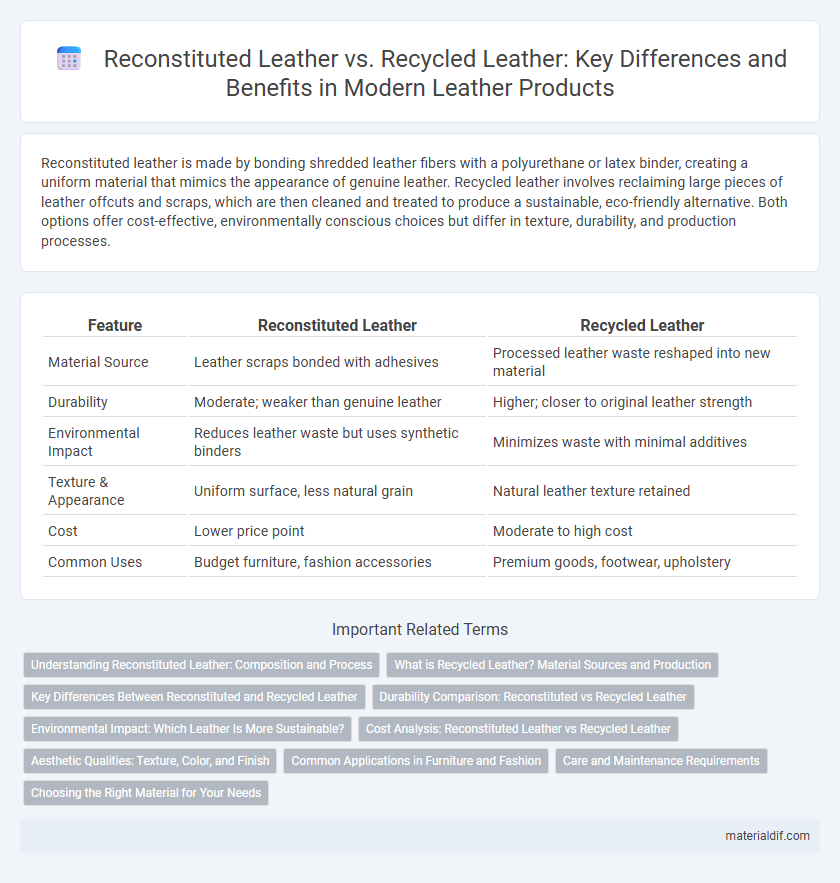Reconstituted leather is made by bonding shredded leather fibers with a polyurethane or latex binder, creating a uniform material that mimics the appearance of genuine leather. Recycled leather involves reclaiming large pieces of leather offcuts and scraps, which are then cleaned and treated to produce a sustainable, eco-friendly alternative. Both options offer cost-effective, environmentally conscious choices but differ in texture, durability, and production processes.
Table of Comparison
| Feature | Reconstituted Leather | Recycled Leather |
|---|---|---|
| Material Source | Leather scraps bonded with adhesives | Processed leather waste reshaped into new material |
| Durability | Moderate; weaker than genuine leather | Higher; closer to original leather strength |
| Environmental Impact | Reduces leather waste but uses synthetic binders | Minimizes waste with minimal additives |
| Texture & Appearance | Uniform surface, less natural grain | Natural leather texture retained |
| Cost | Lower price point | Moderate to high cost |
| Common Uses | Budget furniture, fashion accessories | Premium goods, footwear, upholstery |
Understanding Reconstituted Leather: Composition and Process
Reconstituted leather is created by shredding scrap leather pieces and blending them with a bonding material, typically polyurethane or latex, to form a new composite material. This process involves layering the mixture onto a fiber backing, then embossing and finishing it to resemble genuine leather texture and appearance. Unlike recycled leather, which involves reusing solid leather pieces, reconstituted leather is essentially engineered from leather fibers and fillers to maximize material utilization.
What is Recycled Leather? Material Sources and Production
Recycled leather is a material produced by grinding scrap leather pieces, such as offcuts and trimmings from the leather manufacturing process, and bonding them with a polyurethane or latex binder to create sheets or rolls. This eco-friendly alternative utilizes leftover leather waste, significantly reducing the environmental impact compared to traditional leather production. The production of recycled leather involves shredding leather scraps, mixing them with binding agents, and pressing the composite into usable leather-like materials for footwear, upholstery, and fashion accessories.
Key Differences Between Reconstituted and Recycled Leather
Reconstituted leather is made from leather scraps and fibers bonded together using adhesives, resulting in a lower durability and quality compared to recycled leather, which is produced by thoroughly cleaning, shredding, and reprocessing used leather to maintain more of its original texture and strength. The production of reconstituted leather often involves synthetic fillers and pigments, affecting breathability and environmental impact, whereas recycled leather retains more natural leather properties, appealing to eco-conscious consumers. Key differences include texture uniformity, environmental footprint, and the extent of leather fiber preservation, with recycled leather offering superior performance and sustainability benefits.
Durability Comparison: Reconstituted vs Recycled Leather
Recycled leather, made by shredding and fusing genuine leather scraps, typically offers higher durability due to its composition retaining natural leather fibers. Reconstituted leather, also known as bonded leather, combines leather byproducts with synthetic materials and adhesives, resulting in lower resistance to wear and tear. The durability gap between recycled and reconstituted leather makes recycled leather a preferred choice for products requiring long-lasting performance.
Environmental Impact: Which Leather Is More Sustainable?
Reconstituted leather is produced by bonding leather scraps with synthetic materials, which often involves adhesives and plastic binders that limit biodegradability, leading to higher environmental impact. Recycled leather, created by mechanically processing and reshaping genuine leather waste without heavy use of synthetic additives, generally offers better sustainability due to lower chemical processing and increased material reuse. Evaluating carbon footprint and landfill reduction, recycled leather typically ranks higher in environmental benefits compared to reconstituted leather.
Cost Analysis: Reconstituted Leather vs Recycled Leather
Reconstituted leather generally offers a more cost-effective solution due to its manufacturing process, which involves bonding leather scraps with a bonding agent, reducing raw material expenses. Recycled leather, made by repurposing existing leather products through mechanical or chemical means, often incurs higher processing costs, impacting its final price. Budget-conscious projects typically prefer reconstituted leather, while recycled leather appeals to those prioritizing sustainability despite a slightly higher cost.
Aesthetic Qualities: Texture, Color, and Finish
Reconstituted leather offers a uniform texture and consistent color due to its engineered production process, often resulting in a smoother and more polished finish. Recycled leather, derived from shredded leather scraps, retains more natural grain variations and color inconsistencies, adding unique character and authenticity to the material. The finish of reconstituted leather tends to be more synthetic and glossy, while recycled leather showcases a matte or distressed appearance, highlighting its reclaimed origin.
Common Applications in Furniture and Fashion
Reconstituted leather is widely used in budget-friendly furniture upholstery and fashion accessories due to its uniform texture and cost-effectiveness, whereas recycled leather, made from shredded genuine leather offcuts, is preferred in premium furniture and high-end fashion items for its durability and authentic leather feel. Both types offer sustainable alternatives to traditional leather, with reconstituted leather primarily found in sofas, chairs, belts, and wallets, while recycled leather is prominent in designer bags, shoes, and luxury car interiors. The choice between them depends largely on the desired balance between appearance, durability, and environmental impact in furniture and fashion manufacturing.
Care and Maintenance Requirements
Reconstituted leather requires gentle cleaning with a damp cloth and mild soap to prevent surface damage, as its fiber composition is more delicate than natural leather. Recycled leather often involves tougher fibers that can withstand more robust cleaning methods, but prolonged exposure to moisture or harsh chemicals can still degrade its integrity. Both materials benefit from regular conditioning with specialized leather care products to maintain flexibility and prevent cracking.
Choosing the Right Material for Your Needs
Reconstituted leather is made by bonding leather fibers with adhesives, offering a cost-effective option with consistent texture but lower durability compared to genuine leather. Recycled leather involves reprocessing scrap leather to create new material, providing improved sustainability and strength while retaining more of leather's natural characteristics. Selecting between reconstituted and recycled leather depends on your priorities for durability, appearance, and environmental impact in your specific application.
Reconstituted Leather vs Recycled Leather Infographic

 materialdif.com
materialdif.com